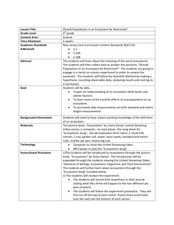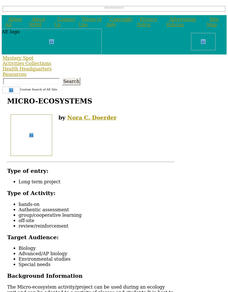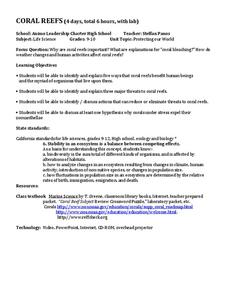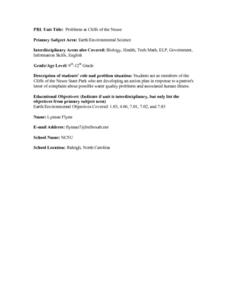Curated OER
Medic!
Learners navigate and analyze information about the presentation of a disease during a class discussion. They document and share their analysis of information in a class discussion in order to describe a variety of disease origins.
Curated OER
Should Populations in an Ecosystem be Restricted?
Fourth graders experiment to determine how overpopulation effects ecosystems specifically plants. In this ecosystem lesson, 4th graders conduct an ecosystems experiment after listening to Claire Daniel's, Ecosystems. They watch a video,...
Curated OER
Bioplastics
Students define bioplastics and identify its uses. In this bioplastics lesson, students compare and contrast styrofoam to starch peanuts after careful examination. Students understand what biodegradeable means.
Curated OER
Island Biogeography and Evolution
Students use this activity as a logic problem that is based on real organisms and real data. The problem is to develop phylogenies for seven related populations of lizards living on the Canary Islands. Three phylogenetic charts are...
Curated OER
Island Biogeography and Evolution: Solving a Phylogenetic Puzzle With Molecular Genetics
Young scholars engage in solving a logic problem based on real organisms and real data. They develop phylogenies for seven related populations of lizards living on the Canary Islands.
Curated OER
Sea Urchin Embryology
Students explore the process of evolution. They examine examples of how homeotic genes may work and obtain gametes. Using a microscope, students observe the fertilization of sea urchins. They video tape the process and write a...
Curated OER
The Columbian Exchange
Tenth graders examine the consequences of Spanish exploration of the New World on animals, humans, and plants. They read and discuss an informational handout, define key vocabulary terms, and complete a Venn Diagram with Old World and...
Curated OER
It's Challenging Being Green!
Learners influence the plant life cycle as they take care of plants.In this caring for plants lesson, students understand the parts of the plant and their functions in keeping it alive. Learners participate in experiments with plants and...
Curated OER
Micro-Ecosystems
Students create a sustainable, self-contained ecosystem in a ten-gallon aquarium.
Curated OER
Lesson Exchange: Species Interactions (Senior, Science)
Twelfth graders explain relationships and interactions between species, the difference between a fundamental niche and a realized niche. They explore the various species interactions from their classmates through the jigsaw activity.
Curated OER
What's in a Name?
Students study the binomial system of naming organisms. They are given a name of an organism and they must draw a picture of what they think the organism looks like. Then they research the organism, find what it really looks like, and...
Curated OER
Vectors
Students are introduced to the bridge building challenge. They perform two labs and work in small groups to finish the vector worksheet. Students review vector additions. They then move onto the Forces on an Inclined Plane Lab. ...
Curated OER
Coral Reefs
Young scholars research coral reefs and identify their benefits to humans, threats to the reef, how to reduce and eliminate threats, and more. In this coral reef lesson plan, students research the reefs, and take a field trip to an...
Curated OER
Branching Out
Learners investigate the causes and effects of the spread of tree diseases in the U.S., and research certain American species of trees and the diseases that commonly threaten them. They create pamphlets to help identify healthy and...
Curated OER
Food For Thought
High schoolers examine their school population about their health and exercise patterns. They brainstorm a list of factors that influence people to eat the way they do.
Curated OER
Rock Solid
Students investigate the three types of material stress related to rocks. They watch a PowerPoint Presentation, view an online animation of the three types of rock stress, identify the various types of rocks, answer true or false...
Curated OER
Human Body Systems
Students explore the systems that comprise the human body. In this human physiology instructional activity, students create a model of the human body and research a disease from a particular system. Students will then choose to either...
Curated OER
Global Warming
Students are members of the North Carolina Environmental Management Commission. They make recommendations to the "governor" and a panel of his advisors regarding the greenhouse effect and global warming.
Curated OER
Problems at Cliffs of the Neuse
Students assume the roles of members of the Cliffs of the Neuse Sate Park and must develop an action plan in response to a complaint about possible water quality problems and associated human illnesses. Students conduct research on the...
Curated OER
Biospheres
Second graders create models, practice inquiry skills, work with fellow students in teams, and reinforce concepts discussed in class all by using the theme of BIOSPHERES.
Curated OER
Examining the Effects of Space Flight on the Heart, Lungs, and Blood Vessels
Students are able to identify the components of the cardio-vascular system. They are able to describe the way the heart works to pump the blood. Students are able to explain the function of the cardio-vascular system. They are able to...
Curated OER
Rice Farming
Third graders investigate how farmers get more rice from their land. In this farming instructional activity, 3rd graders discover things that farmers to do produce more rice. Students study photosynthesis and illustrate pictures about...
Curated OER
Environment: The River Classroom
Seventh graders engage in hands-on experiments and activities dealing with rivers and greenways. They also observe lectures and demonstrations by experts in water and river restoration. Students and teachers participate in canoe trips...
Curated OER
Earthworm Movement and Landscape Structure
Students describe differences in animal usage of habitats depending upon successional status of site. They also design other experiments to test movement patterns of animals through habitats of differing structure.

























